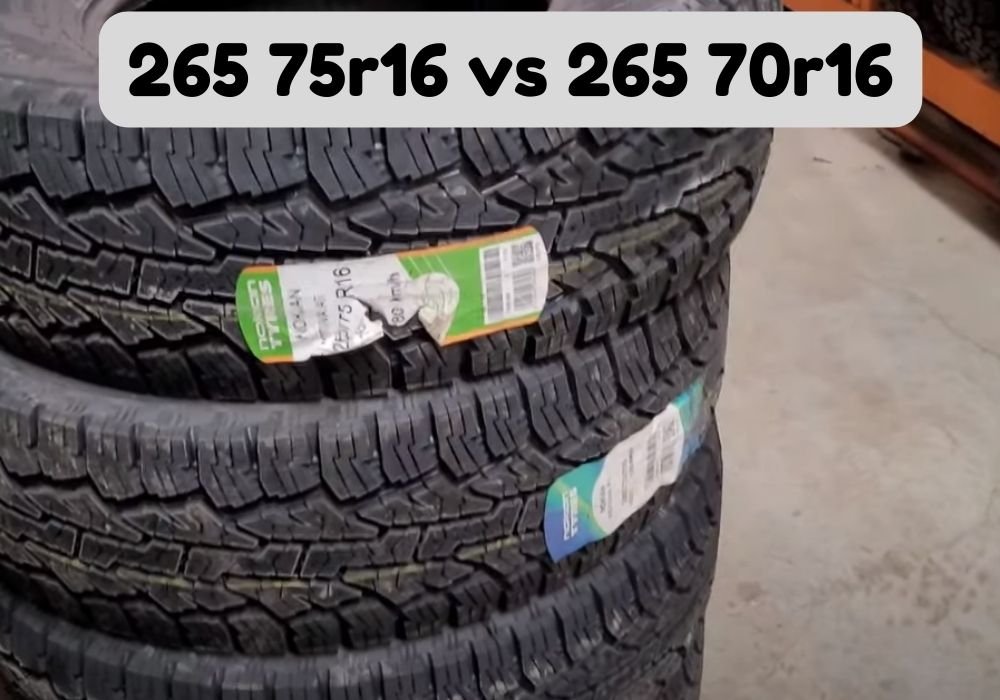Tires are one of the most critical components of a vehicle, playing a pivotal role in ensuring safety, performance, and fuel efficiency. When it comes to selecting the right tires for your vehicle, understanding the various tire sizes and their implications is essential. In this guide, we will delve into the key differences between two common tire sizes: 265/75R16 and 265/70R16. These numbers might seem like a cryptic code at first, but they hold valuable information about the tire’s dimensions and characteristics, which can significantly impact your driving experience.
Whether you’re a seasoned automotive enthusiast or a novice looking to make an informed tire choice, this exploration will shed light on the distinctions between these two tire sizes. By the end of this article, you’ll have a clear understanding of the differences and be better equipped to choose the right set of tires for your vehicle’s specific needs. Let’s dive into the world of tires and unravel the mysteries behind the numbers 265/75R16 and 265/70R16.
Contents
Tire Size Basics:
Understanding tire sizes is essential when it comes to making informed choices about your vehicle’s performance, safety, and efficiency. Tire sizes are typically represented in a standardized format like 265/75R16 or 265/70R16. In this section, we’ll break down the components of tire size notation and explain their significance:
A. Numbers in the Tire Size (e.g., 265):
- The first number, in this case, “265,” represents the tire’s width in millimeters. It indicates the cross-sectional width of the tire when mounted on the recommended rim width. A larger number means a wider tire.
B. Aspect Ratio (75 vs. 70):
- The aspect ratio is represented as a percentage and is the second number in the tire size (e.g., 75 or 70). It signifies the height of the tire’s sidewall as a percentage of its width.
- For example, in 265/75R16 tires, the sidewall height is 75% of the tire’s width, whereas in 265/70R16 tires, it’s 70%.
C. Rim Diameter (16):
- The last number, in this case, “16,” denotes the diameter of the wheel or rim in inches onto which the tire is meant to be mounted.
Understanding these basic components of tire size notation is crucial for selecting the right tires for your vehicle. In the case of 265/75R16 and 265/70R16 tires, differences in width, aspect ratio, and rim diameter will have distinct effects on your driving experience, vehicle handling, and performance. In the following sections, we’ll explore these differences in more detail, helping you make an educated choice based on your specific needs and preferences.
265/75R16 Tires:
Now that we’ve covered the fundamentals of tire size notation, let’s take a closer look at 265/75R16 tires. This tire size is a popular choice for various vehicles, and understanding its specifications and characteristics is essential when deciding whether it’s the right fit for your needs.
A. Detailed Description of 265/75R16 Tires:
- Width (265):
- These tires have a width of 265 millimeters, making them relatively wide. A wider tire can offer better stability and grip, especially in off-road conditions.
- Aspect Ratio (75):
- The aspect ratio of 75 means that the sidewall height is 75% of the tire’s width. This results in a taller sidewall, which can provide a smoother and more comfortable ride, as well as improved performance on rough terrain.
- Rim Diameter (16):
- These tires are designed to fit on 16-inch rims. The 16-inch rim size is common for trucks, SUVs, and some larger vehicles.
B. Pros and Cons of Using 265/75R16 Tires:
- Pros:
- Enhanced off-road capability: The wider footprint and taller sidewall of these tires make them well-suited for off-road adventures, providing excellent traction and cushioning on uneven terrain.
- Comfortable ride: The taller sidewalls can absorb road imperfections, leading to a smoother and more comfortable ride.
- Improved load-carrying capacity: 265/75R16 tires often have a higher load-carrying capacity, making them suitable for trucks and SUVs that may carry heavy loads.
- Cons:
- Reduced fuel efficiency: Wider tires can sometimes result in slightly reduced fuel efficiency compared to narrower options.
- Handling trade-off: While they offer excellent off-road performance and comfort, 265/75R16 tires may not be as responsive in sharp turns and high-speed maneuvers as lower-profile tires.
C. Suitable Vehicles and Driving Conditions for 265/75R16 Tires:
- These tires are commonly found on trucks, SUVs, and certain 4×4 vehicles. They are ideal for:
- Off-road enthusiasts who require excellent traction on rugged terrain.
- Those seeking a comfortable and cushioned ride for daily driving and long journeys.
- Vehicles used for towing or carrying heavy loads due to their enhanced load-carrying capacity.
As you consider 265/75R16 tires for your vehicle, it’s important to weigh their advantages and disadvantages against your specific driving needs and preferences. If you require off-road capability and a comfortable ride, these tires may be an excellent choice for you. However, if fuel efficiency and precise handling are top priorities, other tire sizes might better suit your requirements.
265/70R16 Tires:
Now, let’s delve into the details of 265/70R16 tires, another common tire size. Understanding the specifications and characteristics of these tires will help you determine if they are the right fit for your vehicle and driving needs.
A. Detailed Description of 265/70R16 Tires:
- Width (265):
- Like their 265/75R16 counterparts, these tires have a width of 265 millimeters, making them relatively wide. The width contributes to stability and grip on various road surfaces.
- Aspect Ratio (70):
- The aspect ratio of 70 indicates that the sidewall height is 70% of the tire’s width. This results in a slightly lower sidewall compared to 265/75R16 tires, which can impact ride comfort and performance.
- Rim Diameter (16):
- These tires are designed to fit on 16-inch rims, which is a common size for many vehicles.
B. Pros and Cons of Using 265/70R16 Tires:
- Pros:
- Balanced performance: 265/70R16 tires offer a balance between stability and comfort. They are suitable for both on-road and light off-road use.
- Improved fuel efficiency: Compared to wider tires, these tires can provide slightly better fuel economy due to their narrower width.
- Handling and responsiveness: The lower sidewall height can result in better handling and responsiveness during cornering and high-speed driving.
- Cons:
- Reduced off-road capability: While they can handle some light off-road conditions, 265/70R16 tires may not provide the same level of traction and cushioning as taller, wider tires.
- Slightly less comfortable ride: The lower sidewall can transmit road imperfections more directly to the vehicle’s suspension, potentially resulting in a slightly firmer ride.
C. Suitable Vehicles and Driving Conditions for 265/70R16 Tires:
- These tires are commonly found on a wide range of vehicles, including SUVs, crossovers, and light trucks. They are suitable for:
- Everyday commuting and highway driving, where fuel efficiency and handling are important.
- Vehicles used for light off-road adventures, such as occasional camping trips and gravel roads.
- Drivers who prioritize a balance between performance, comfort, and versatility.
Choosing 265/70R16 tires can be an excellent option if you need a tire size that strikes a balance between various factors like fuel efficiency, handling, and light off-road capability. Consider your specific driving habits and the conditions you encounter to determine if these tires align with your needs and preferences.
key differences between 265/75R16 and 265/70R16 tires:
| Aspect | 265/75R16 Tires | 265/70R16 Tires |
| Width (mm) | 265 | 265 |
| Aspect Ratio (%) | 75 | 70 |
| Rim Diameter (inches) | 16 | 16 |
| Sidewall Height (mm) | Taller sidewall, more cushioning | Slightly lower sidewall, firmer ride |
| Off-road Capability | Excellent off-road traction and cushioning | Good for light off-road use |
| On-road Comfort | Very comfortable ride due to tall sidewalls | Comfortable, but slightly firmer ride |
| Handling and Responsiveness | Not as precise in sharp turns | Offers better handling and responsiveness |
| Fuel Efficiency | Slightly reduced compared to 265/70R16 | Slightly better due to narrower width |
| Load-Carrying Capacity | Often higher, suitable for heavy loads | Suitable for standard loads |
| Suitable Vehicles | Trucks, SUVs, off-road enthusiasts | SUVs, crossovers, light trucks |
| Common Use Cases | Off-roading, heavy loads, comfort-oriented driving | Versatile for everyday use, light off-roading |
This table provides a clear and concise comparison of the two tire sizes, making it easier to understand their differences and choose the one that best aligns with your driving needs and preferences.
Factors to Consider When Choosing Between 265/75R16 and 265/70R16 Tires:
When deciding between 265/75R16 and 265/70R16 tires, several important factors should influence your choice. Your decision should align with your vehicle type, driving habits, and specific needs. Here are key factors to consider:
A. Vehicle Type:
- Consider the type of vehicle you drive. Are you driving a truck, SUV, crossover, or another type of vehicle? The suitability of these tire sizes may vary based on your vehicle’s design and intended use.
B. Intended Use:
- Determine how you primarily use your vehicle. Are you mainly driving on highways, city roads, or do you frequently venture off-road? Your driving environment plays a significant role in the choice of tire size.
C. Weather and Terrain Conditions:
- Think about the typical weather and terrain conditions you encounter. If you live in an area with frequent rain, snow, or off-road trails, the choice between these tire sizes can impact your vehicle’s performance and safety.
D. Load-Carrying Capacity:
- Assess whether you often carry heavy loads or tow trailers. If so, you’ll want to choose a tire size that can handle the weight comfortably without compromising safety and performance.
E. Fuel Efficiency:
- Consider your fuel efficiency priorities. If you want to maximize fuel economy, the slightly narrower 265/70R16 tires may be more appealing due to their reduced rolling resistance.
F. Ride Comfort:
- Evaluate your preference for ride comfort. If you prioritize a smoother, cushioned ride, the taller sidewalls of 265/75R16 tires can provide more comfort, especially on rough roads.
G. Handling and Responsiveness:
- Think about your preference for handling and responsiveness. If you prioritize precise steering and cornering, 265/70R16 tires with a lower sidewall may offer better control.
H. Budget:
- Consider your budget for tire replacement. Different tire sizes and models can vary in price, so ensure your choice aligns with your financial constraints.
By carefully considering these factors, you can make an informed decision between 265/75R16 and 265/70R16 tires, ensuring that your choice enhances your vehicle’s performance and safety while aligning with your driving preferences and conditions.
Conclusion:
Choosing the right tire size for your vehicle is a decision that shouldn’t be taken lightly. In this guide, we’ve explored the key differences between 265/75R16 and 265/70R16 tires, and we’ve discussed the factors to consider when making this important choice.
As you conclude your tire selection process, here are some key takeaways to remember:
- Tire Size Matters: The numbers on your tire sidewall aren’t just arbitrary codes; they represent critical aspects of tire size that influence your vehicle’s performance and safety.
- Consider Your Vehicle and Needs: Think about your vehicle type, driving habits, and typical road conditions. Your choice should align with your specific needs and preferences.
- Off-Roading vs. On-Road Comfort: If you’re an off-road enthusiast or prioritize a comfortable ride, 265/75R16 tires might be your top pick. On the other hand, if you want a versatile tire that performs well on highways and light off-road trails, 265/70R16 tires are a solid choice.
- Handling vs. Fuel Efficiency: If handling and responsiveness are paramount, 265/70R16 tires offer an advantage. However, if you’re concerned about fuel economy, the narrower 265/70R16 tires may be a better fit.
- Load Capacity: If you frequently carry heavy loads or tow trailers, pay attention to load-carrying capacity. Choose a tire size that can safely accommodate your cargo.
- Consult the Experts: Don’t hesitate to seek advice from tire experts or consult your vehicle’s manufacturer recommendations. Their guidance can help you make an informed choice.
In conclusion, the decision between 265/75R16 and 265/70R16 tires hinges on your unique requirements and priorities. Both tire sizes have their strengths and weaknesses, and the right choice ultimately depends on your vehicle, driving habits, and the environments you encounter.
By considering all these factors and conducting thorough research, you can select the tire size that not only fits your vehicle but also enhances your driving experience, safety, and overall satisfaction on the road. Make an informed choice, and enjoy the journey with the perfect set of tires for your needs.
Frequently asked questions (FAQs) :
What do the numbers in tire size notation mean, such as 265/75R16 and 265/70R16?
The numbers represent various aspects of the tire:
- “265” is the tire’s width in millimeters.
- The first number after the slash (“/”) indicates the aspect ratio, which is the height of the tire’s sidewall as a percentage of its width.
- “R” stands for radial construction, which is the most common type of tire construction.
- “16” is the diameter of the wheel (rim) in inches onto which the tire is meant to be mounted.
What is the main difference between 265/75R16 and 265/70R16 tires?
The primary difference is in the aspect ratio:
- 265/75R16 tires have a taller sidewall (75% of the tire’s width) compared to 265/70R16 tires, which have a slightly lower sidewall (70% of the tire’s width). This affects the ride comfort, handling, and overall tire performance.
Which tire size is better for off-roading?
265/75R16 tires are generally better suited for off-roading due to their taller sidewalls, which provide more cushioning and better traction on uneven terrain. They are often preferred by off-road enthusiasts.
Are 265/70R16 tires better for highway driving?
Yes, 265/70R16 tires tend to perform well on highways and offer a good balance between comfort and handling. Their slightly lower sidewall can enhance stability during highway driving.
Do these tire sizes affect fuel efficiency?
Yes, tire size can impact fuel efficiency. In general, 265/70R16 tires may provide slightly better fuel economy compared to 265/75R16 tires due to their narrower width and lower rolling resistance.
Can I switch between these two tire sizes on my vehicle?
A6: It’s possible to switch between these tire sizes if they are compatible with your vehicle’s specifications and there is enough clearance in the wheel well. However, it’s essential to consult your vehicle’s manufacturer recommendations and consider potential impacts on speedometer accuracy and handling.
Are there specific vehicles that come with either of these tire sizes as factory options?
Yes, various trucks, SUVs, and crossover models come equipped with either 265/75R16 or 265/70R16 tires as factory options. Check your vehicle’s owner’s manual or consult the manufacturer to confirm the recommended tire size for your particular model.
Affiliate Disclosure: As an Amazon Associate, I earn from qualifying purchases made through links on this site.








